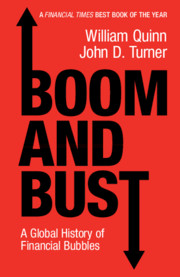Book contents
- Boom and Bust
- Boom and Bust
- Copyright page
- Contents
- Figures
- Tables
- Chapter 1 The Bubble Triangle
- Chapter 2 1720 and the Invention of the Bubble
- Chapter 3 Marketability Revived: The First Emerging Market Bubble
- Chapter 4 Democratising Speculation: The Great Railway Mania
- Chapter 5 Other People’s Money: The Australian Land Boom
- Chapter 6 Wheeler-Dealers: The British Bicycle Mania
- Chapter 7 The Roaring Twenties and the Wall Street Crash
- Chapter 8 Blowing Bubbles for Political Purposes: Japan in the 1980s
- Chapter 9 The Dot-Com Bubble
- Chapter 10 ‘No More Boom and Bust’: The Subprime Bubble
- Chapter 11 Casino Capitalism with Chinese Characteristics
- Chapter 12 Predicting Bubbles
- Acknowledgements
- Notes
- Bibliography
- Index
Chapter 9 - The Dot-Com Bubble
Published online by Cambridge University Press: 06 August 2020
- Boom and Bust
- Boom and Bust
- Copyright page
- Contents
- Figures
- Tables
- Chapter 1 The Bubble Triangle
- Chapter 2 1720 and the Invention of the Bubble
- Chapter 3 Marketability Revived: The First Emerging Market Bubble
- Chapter 4 Democratising Speculation: The Great Railway Mania
- Chapter 5 Other People’s Money: The Australian Land Boom
- Chapter 6 Wheeler-Dealers: The British Bicycle Mania
- Chapter 7 The Roaring Twenties and the Wall Street Crash
- Chapter 8 Blowing Bubbles for Political Purposes: Japan in the 1980s
- Chapter 9 The Dot-Com Bubble
- Chapter 10 ‘No More Boom and Bust’: The Subprime Bubble
- Chapter 11 Casino Capitalism with Chinese Characteristics
- Chapter 12 Predicting Bubbles
- Acknowledgements
- Notes
- Bibliography
- Index
Summary
Chapter 9 examines the bubble in internet and other technology stocks that occurred at the end of the 1990s. This bubble witnessed the coming to market of many young firms which had never generated a profit. The excitement resulted in the NASDAQ index trebling in value in the 18 months prior to its peak in March 2000. By the end of 2000, however, it had lost more than half of its value. This bubble in tech stocks was not confined to the United States – it was a global phenomenon. The chapter then uses the bubble triangle can explain the causes of the dot-com bubble. The spark was provided by the new internet technology. Marketability increased as a result of new technology and many more companies floating on stock exchanges. Monetary conditions were loose in the runup of the bubble and there was a sharp rise in margin lending. Speculation was rampant in the runup, thanks to the rise of the day trader. The chapter concludes by arguing that the modest levels of economic damage associated with the bursting of the dot-com bubble suggest it could have been useful. However, its minor economic impact might also have made the authorities and investors complacent about the housing bubble which followed on its heels.
- Type
- Chapter
- Information
- Boom and BustA Global History of Financial Bubbles, pp. 152 - 169Publisher: Cambridge University PressPrint publication year: 2020
- 2
- Cited by



